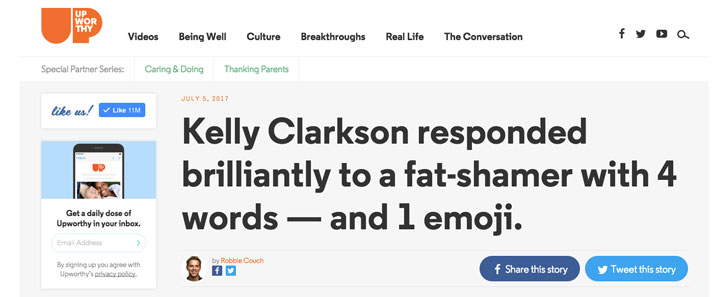Guest post by Andy Beohar.
Some business owners and bloggers are under the assumption that if they consistently post content, they will automatically start to boost traffic (“If you build it, they will come”).
 Though consistency is important, the truth is that your content has to have an audience to be effective. One of the best ways to build this audience is by getting users to share your content regularly.
Though consistency is important, the truth is that your content has to have an audience to be effective. One of the best ways to build this audience is by getting users to share your content regularly.
But with two million blog posts published every day, it can be a challenge to develop content that stands out, that cuts through the noise and entice users to read and share your content. In this post, you’ll discover three science-backed secrets to creating content that is more likely to be shared online.
- Create content that’s easy to digest.
A couple of years ago, Moz and BuzzSumo got together to analyze the shares and links for one million articles to determine what factors impact sharing. It will probably come as no surprise to find out list-posts and videos achieved higher numbers of shares than any other content formats. Today’s digital consumer is bombarded with information every time they go online or open an app. Easily consumable content like lists and videos make it easy for them to get the information they need.
Though you may love to hate the listicle, it’s effective because it’s easy to scan and understand. The key to creating list articles that get shared is going beyond what’s already been said and finding a way to provide some value. This doesn’t always have to be a list of tips or tricks. You can also use lists to entertain your reader.
Motorcycler’s “Top 9 Funniest Motorcycle Ads” is an excellent example of a list post that is relevant to the site’s target audience but purely entertaining in nature. Not only does this type of easy-to-consume content help build relationships with your readers, but it is also more likely to be shared.
If you want to create content that is easy to consume, keep the following in mind:
- Eliminate fluff. If you want to develop easy-to-read content, you need to get to the point quickly. Avoid adding any unnecessary “fluff” that doesn’t add to the value of the piece.
- Use headings and bullet points. Headings and bullet points help break down the content into chunks that are easier for the reader to digest. Make sure that any headings you use are informative yet concise.
- Include compelling visuals. Photos, videos, and other images can help make your content easier to understand. From how-to videos that break down step-by-step processes to stunning infographics that make it easier to comprehend statistics, visuals can go a long way in helping you communicate your ideas to your audience.
In the end, short and concise posts that are easy to read and understand are the key to getting more readers to share your content online. Remember, short doesn’t mean without value. You should still be aiming to produce content that is useful to your target audience.
- Speak to your reader’s core motivations.
An interesting report from researchers at UCLA shows that ideas that are found to be buzz-worthy are associated with certain areas of the brain. This means that there is a neurological component to what types of information and content people share. The study showed that the urge to share tends to be driven by the types of content that fulfill a reader’s desire for entertainment, utility, and inspiration. Ultimately, this suggests that if you want to create viral content, you need to appeal to these core motivations.
It’s probably no surprise that entertaining content creates the most buzz. Laughing makes people feel good, and they want to share this experience with others. However, when you’re dealing with a serious or boring topic, it can sometimes be a challenge to create entertaining content. But it is not impossible!
Sometimes the key to making boring topics entertaining is finding a new way to present information. Take HVAC.com, for instance. This site aims to educate homeowners and connect them with the right HVAC contractors. Despite the fact that HVAC (heating, ventilation, and air conditioning) is one of the least exciting topics out there, HVAC.com still finds ways to make it entertaining.
HVAC.com entertains readers while educating them on what not to do with their HVAC system. As a bonus, they can take advantage of the “HVAC hacks” trend to make a compelling point that helps promote their services.
Content that speaks to a reader’s need for utility is another highly shareable type of content. Utility-focused content provides useful information or helpful tips that the reader can apply to their own lives in some way. LifeHacker is a great example of a site with content that focuses on providing utility. The blog publishes articles that offer tips and tricks for making many aspects of life easier. These are the types of articles that we want to share with friends, family, and colleagues out of our desire to help others. To create your own utility-focused content, consider what useful information you can provide to the audience.
The last type of content that people are most likely to share is content that provides inspiration. Upworthy.com has built their audience on the platform of providing inspirational content. Currently, it is one of the fastest growing media companies in the world with 5.7 million unique visits in the last month alone. People share the content that they find on this site because it has inspired or motivated them in some way.
Though your content may not be focused on stories that “change the world,” you can still provide inspiration by encouraging your readers to look at things in a new way or helping them overcome the major challenges they face.
- Appeal to the audience’s emotions.
One of the best ways to get the attention (and the shares) of your audience is to evoke an emotional response with your content. Research presented in Psychological Science suggests that a reader’s emotional response to content plays a significant role in whether or not they decide to share that content. Though you might have guessed that on your own, what may come as a surprise is that this does not just apply to content that evokes positive emotions like excitement or joy.
The research suggests that readers are more likely to share content that has made them feel a strong emotion, which includes both positive emotions like happiness and negative emotions such as anxiety. Although, it is important to note that some negative emotions—like sadness—actually made readers less likely to share the content. To be safe, focus on creating content that appeals to a reader’s feelings of positivity.
If you want to create emotional investment in your content, you will need first to consider what your target audience finds most important. What keeps them up at night? What motivates them to do what they do? After you have figured out what motivates your audience and what they care about most, work to develop content that evokes an emotional response based on these values.
For instance, if your brand’s target audience is mothers, you could create content that appeals to their love for their children. Huggies, Kraft, and Fisher-Price are all great examples of brands that use content marketing to appeal to their audience’s desire to do what is best for their children. These sites can create content that invokes strong emotions in their audience—whether it’s content that helps women overcome the challenges of being a new mom or information about child safety and health. Mothers are likely to share this content within their communities because they want other mothers to feel the same positive feelings that stem from being able to provide a better life for their children.
Final Takeaways
These tips give you an excellent starting point for creating more engaging and shareable content. In addition to focusing on content formats that are easy to read, you will also need to appeal to your target audience’s core motivations and the emotions that correspond to these values. That means getting to know who your audience is and what they find important—before you develop your content marketing strategy.
In the end, it is not enough to just get readers to click. If you want your audience to share your blog posts, articles, videos, and other content, then you will need to create the type of content that is worthy of sharing. This means producing high-quality, well-researched content that provides real value for your readers. The more helpful and engaging your content is, the more likely your readers will be to share it with others.
 About the author: Andy Beohar is the Chief Inbound Marketing Strategist at SevenAtoms Inc, a San Francisco Inbound Marketing and PPC Agency. At SevenAtoms, he manages and develops inbound marketing and Google AdWords strategies for companies to increase their online visibility, grow their brand, and bring in more leads and conversions.
About the author: Andy Beohar is the Chief Inbound Marketing Strategist at SevenAtoms Inc, a San Francisco Inbound Marketing and PPC Agency. At SevenAtoms, he manages and develops inbound marketing and Google AdWords strategies for companies to increase their online visibility, grow their brand, and bring in more leads and conversions.





